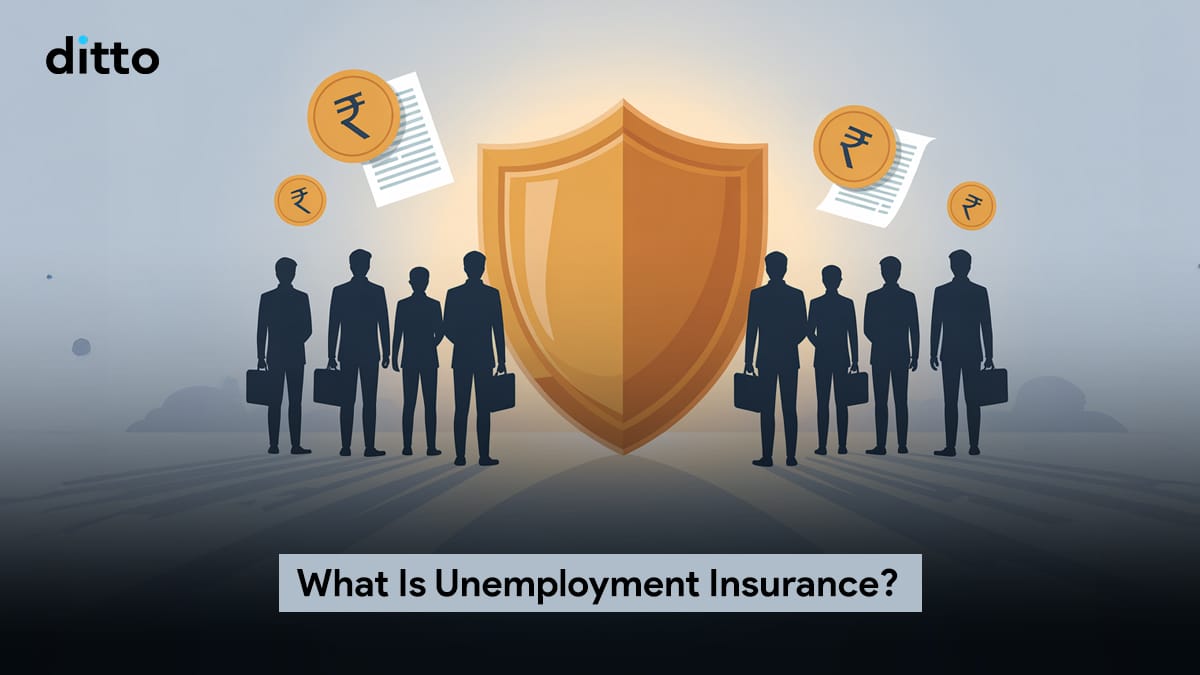| What is Unemployment Insurance? Unemployment insurance in India is a government-backed system that provides temporary financial support to organized sector workers who lose their jobs involuntarily. It operates primarily through schemes like the Atal Beemit Vyakti Kalyan Yojana (ABVKY) and Rajeev Gandhi Shramik Kalyan Yojana (RGSKY) under the Employees’ State Insurance (ESI) Act, offering up to 50% of wages for a limited period to eligible employees. However, India does not have a universal, nationwide unemployment insurance that covers all workers. Most of the informal and self-employed workforce remains outside its scope. Some states provide additional support through unemployment allowances such as Berojgari Bhatta, but these benefits are generally minimal. Overall, unemployment protection in India is limited, highlighting the need for broader and more inclusive job-loss support. |
Losing a job can be a stressful experience, not just emotionally but also financially. Unemployment insurance exists to provide temporary financial support to workers who lose their jobs involuntarily, helping them stay afloat while searching for new employment.
In India, programs like the Atal Beemit Vyakti Kalyan Yojana (ABVKY) and Rajeev Gandhi Shramik Kalyan Yojana (RGSKY) under the Employees’ State Insurance (ESI) Act offer relief to organized sector employees, though millions in the informal sector remain without coverage. Recent official data indicate that India’s unemployment rate has hovered around 4% to 6% in the last few years.
In developed countries, unemployment insurance generally operates as a contributory social insurance system. Both workers and employers contribute a small percentage of wages to a national fund. When a worker is laid off, they receive a portion of their previous salary, typically between 50% and 70%, for a fixed period, usually ranging from six to twelve months. For example,
a) United States: State programs offer temporary weekly benefits to workers who lose their jobs involuntarily.
b) Japan: The Employment Insurance system provides income-linked benefits based on prior wages.
c) Germany: Workers receive approximately 60% of their previous net earnings, or 67% if they have children.
To qualify for these benefits, claimants are usually required to seek work actively, remain available for suitable job opportunities, and meet minimum contribution requirements.
What Are the 4 Types of Unemployment?
Unemployment isn’t a one-size-fits-all problem; different people lose jobs for different reasons, and understanding these distinctions helps both workers and policymakers. In India, unemployment is broadly classified into four main types, each with its own causes and solutions:
1.) Cyclical Unemployment: This type of unemployment occurs due to economic slowdowns or recessions. For example, during a nationwide economic slowdown, manufacturing or export-dependent industries may reduce jobs temporarily or permanently.
2.) Structural Unemployment: This type of unemployment arises when there is a mismatch between the skills workers have and the skills employers need. For instance, traditional handloom workers may lose their jobs if factories switch to machine production, or IT professionals may need to learn new programming skills to remain employable.
3.) Frictional Unemployment: This type of unemployment is short-term and happens when individuals are transitioning between jobs, entering the workforce for the first time, or relocating. For example, a recent college graduate may take a few weeks or months to find a position that fits their skills and career goals.
4.) Seasonal Unemployment: This type of unemployment occurs when jobs are available only during specific times of the year. For example, farm laborers may be out of work after the harvest season, and tourist guides may experience gaps during off-peak months.
Worried about your financial safety net if you lose your job? Speak to a Ditto advisor to get the right protection and make sure you and your family are covered in uncertain times.
How Is Unemployment Calculated in India?
India measures unemployment through the Periodic Labor Force Survey (PLFS), which tracks the employment status of people aged 15 and above. The survey identifies individuals who are actively seeking work but are unable to find a job.
The unemployment rate is calculated using the following formula:
Unemployment Rate = (Number of people without a job ÷ Total number of people in the workforce) × 100
Here:
- Number of Unemployed People = Individuals who are willing and able to work but currently do not have a job.
- Total Labor Force = Sum of employed and unemployed individuals actively participating in the workforce.
In India, some insurers offer involuntary job-loss cover bundled with home loans or other credit products. These plans pay your EMIs for a short period (around 3 months) if you’re laid off, but they don’t replace your salary. They often exclude resignations, misconduct, probation, or contract roles, and non-payroll employment, and you may need documents like termination letters and proof of tenure to claim.
| Did you know? You can enhance a term insurance plan with riders like Critical Illness (CI), Total & Permanent Disability (TPD), and Waiver of Premium (WOP). These won’t pay simply because you’re unemployed, but they protect your income if illness, disability, or covered events prevent you from working. a) CI: Lump-sum payout for treatment, income replacement, and living costs. b) TPD: Payout if you can no longer work permanently. c) WOP: Keeps your term cover active by waiving future premiums after a covered event. Standalone Personal Accident (PA) policies may include a weekly income benefit for temporary work incapacity due to accidents, but not for layoffs. Some lenders also offer loan/EMI protection with short-term involuntary job-loss cover. These typically pay EMIs for a few months, but have strict conditions and exclusions, so check the fine print. While health insurance does not replace lost income due to unemployment, it protects your finances if illness or hospitalization prevents you from earning: 1) Pays for hospitalization and treatment costs, reducing financial strain during illness. 2) Some policies include a critical illness benefit, providing a lump sum to cover living expenses while you recover. 3) Certain plans may offer partial income support in case of temporary or permanent disability due to illness. Health insurance does not pay simply because you are unemployed, but it safeguards your savings and financial stability. |
How is Unemployment Insurance Funded in India?
Unemployment insurance in India is primarily financed through contributions to the Employees’ State Insurance (ESI) scheme:
- Employer Contribution: 3.25% of the employee’s wages
- Employee Contribution: 0.75% of wages
These funds are used to provide various ESI benefits, including unemployment support in specific cases.
Additionally, state unemployment allowances (like Berojgari Bhatta) are often supplemented by general government funds and taxes.
The ESI contribution system provides a limited but targeted safety net for unemployed workers in India.Who Can Get Unemployment Insurance Benefits in India?
To qualify for unemployment insurance under India’s Employees’ State Insurance (ESI) scheme, you must meet these conditions:
- ESI Registration: You should be registered under the ESI Act for a certain minimum period (1 or 3 years, depending on the scheme).
- Involuntary Job Loss: Your job must have ended due to reasons beyond your control, such as retrenchment, factory closure, or disability from a work-related injury.
- Timely Notification: You must inform the authorities within 6 months of losing your job.
- Limited Duration: Benefits are temporary, usually for 1 to 2 years, and stop as soon as you start a new job.
- No Voluntary Resignation: Leaving your job voluntarily does not make you eligible.
These benefits are only available to employees covered under the ESI Act, which mainly includes organized sector workers.
Unemployment Support in India
India does not have universal unemployment insurance, but there are several programs and provisions that provide financial support to certain workers, either as social assistance or from their own savings. These can be broadly categorized as follows:
1. Job-Guarantee Programs (Not Insurance): MGNREGA (Rural)
The Mahatma Gandhi National Rural Employment Guarantee Act (MGNREGA), enacted in 2005, is a right-based rural job-guarantee scheme, not an insurance program. It guarantees every rural household up to 100 days of wage employment per year for unskilled manual labor at government-determined daily wages.
If a registered household requests work and the government fails to provide it within 15 days, the family becomes eligible for an “unemployment allowance”, a partial cash payment meant to compensate for the delay. This allowance is not linked to prior earnings or job loss, and workers do not need to make any contributions.
Funded entirely by the government, MGNREGA functions as a social safety net against rural distress, seasonal unemployment, and poverty, particularly during agricultural off-seasons or economic shocks. While it provides vital support, it is fundamentally a job-creation guarantee, not income-replacement insurance.
2. EPF Withdrawals During Unemployment (Own Savings, Not Insurance)
Under the Employees’ Provident Fund (EPF) Scheme, workers contribute 12% of their monthly wages (matched by the employer) to build retirement savings. Clause 68HH allows partial withdrawals if a member is unemployed for at least one month.
- Workers can withdraw up to 75% of their EPF balance after one month of unemployment.
- If unemployment continues beyond two months, they can withdraw the remaining 25%.
While this provides short-term financial relief, it is not unemployment insurance, as the funds come from the worker’s own savings rather than a pooled insurance fund. The scheme is administered by the Employees’ Provident Fund Organization (EPFO), and premature withdrawals reduce the retirement corpus. Essentially, EPF withdrawals are a self-financed fallback, not an external income-replacement mechanism.
3. State “Unemployment Allowance” Programs (Assistance)
Several Indian states offer unemployment allowances or youth stipends aimed at educated job-seekers. These are welfare-based assistance programs, not insurance, and provide flat-rate financial support funded entirely by state budgets. Eligibility depends on residence, age, education, and income limits, rather than prior contributions or employment history.
- Kerala: The Unemployment Allowance Scheme, managed by local self-governments through the Department of Employment, provides modest monthly support to registered unemployed individuals who meet strict criteria regarding income, job registration, and family situation.
- Rajasthan: The Mukhyamantri Yuva Sambal Yojana (Chief Minister’s Youth Empowerment Scheme) provides a fixed monthly allowance to educated unemployed youth registered with employment exchanges. Benefit amounts and durations vary based on qualifications and gender, and the program is periodically revised.
These state schemes offer temporary financial relief while individuals continue their job search, but they are not linked to previous wages or contributions.
Why Talk to Ditto for Insurance?
At Ditto, we’ve assisted over 8,00,000 customers with choosing the right insurance policy. Why customers like Arun below love us:

✅No-Spam & No Salesmen
✅Rated 4.9/5 on Google Reviews by 15,000+ happy customers
✅Backed by Zerodha
✅Dedicated Claim Support Team
✅100% Free Consultation
Ditto’s Take on Unemployment Insurance
Losing a job can shake up not just your routine but your entire financial balance. Unemployment insurance is meant to soften that blow, offering workers a temporary safety net while they look for new opportunities. In India, though, such protection is still limited. Government-backed programs like the Atal Beemit Vyakti Kalyan Yojana (ABVKY) under the ESI Act provide relief to registered employees, but millions remain outside its reach.
At Ditto, the belief is simple: financial security shouldn’t depend on luck. Having a broader safety net that includes health, life, and accident covers ensures stability even when jobs aren’t available. While unemployment insurance in India is evolving, individuals can still build their own cushion through EPF, PPF, and Investment in emergency funds.
Worried about your financial safety net if you lose your job? Speak to a Ditto advisor to get the right protection and make sure you and your family are covered in uncertain times.
Frequently Asked Questions (FAQs)
Which Indian company provides insurance for unemployment?
No private Indian insurance company offers pure unemployment insurance. Coverage is provided through government schemes like RGSKY and ABVKY for ESI-insured workers.
What is the Atal Beemit Vyakti Kalyan Yojana?
ABVKY is a scheme under ESIC that provides up to 90 days of unemployment relief (50% of wages) for ESI-insured employees who lose their jobs involuntarily.
How much benefit does Rajeev Gandhi Shramik Kalyan Yojana offer?
RGSKY offers an unemployment allowance equal to 50% of wages for the first 12 months and 25% for the next 12 months, along with medical benefits.
Who is eligible for unemployment insurance benefits in India?
Any worker registered under the ESI Act with a minimum qualifying period (typically 3 years for RGSKY, 1 year for ABVKY) and involuntary loss of employment is eligible.
Are there unemployment support schemes for the unorganized sector?
The government and some states offer limited unemployment allowances (like Berojgari Bhatta) for job seekers, but these are not insurance programs and are subject to local policy variations.
Last updated on:








